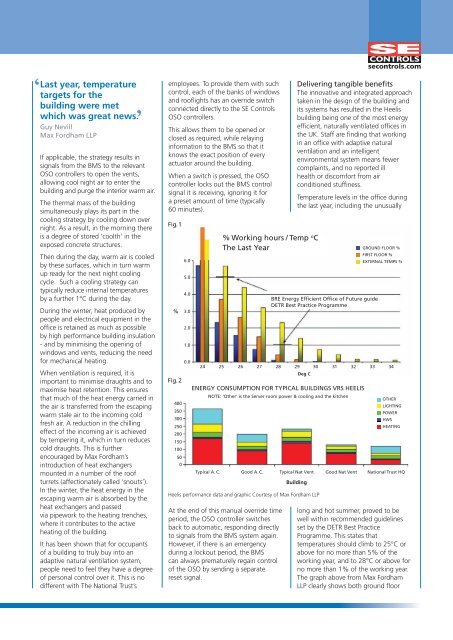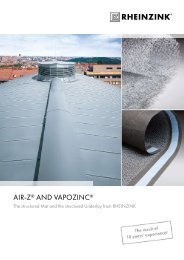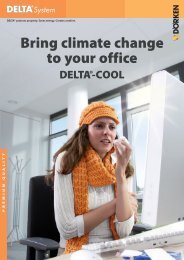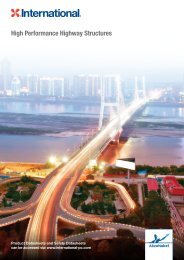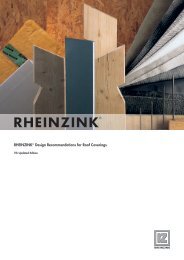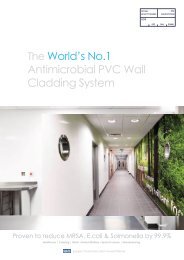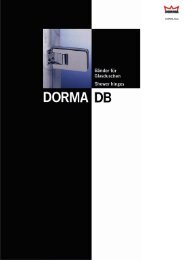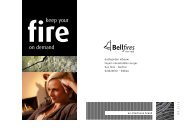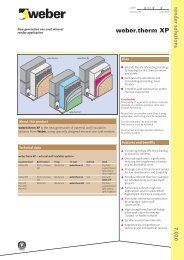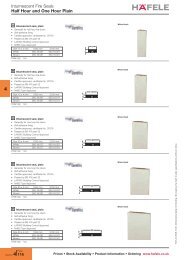Case Study: The National Trust Central Office - RIBA Product Selector
Case Study: The National Trust Central Office - RIBA Product Selector
Case Study: The National Trust Central Office - RIBA Product Selector
You also want an ePaper? Increase the reach of your titles
YUMPU automatically turns print PDFs into web optimized ePapers that Google loves.
Last year, temperature<br />
targets for the<br />
building were met<br />
which was great news.<br />
Guy Nevill<br />
Max Fordham LLP<br />
‘‘<br />
If applicable, the strategy results in<br />
signals from the BMS to the relevant<br />
OSO controllers to open the vents,<br />
allowing cool night air to enter the<br />
building and purge the interior warm air.<br />
<strong>The</strong> thermal mass of the building<br />
simultaneously plays its part in the<br />
cooling strategy by cooling down over<br />
night. As a result, in the morning there<br />
is a degree of stored ‘coolth’ in the<br />
exposed concrete structures.<br />
<strong>The</strong>n during the day, warm air is cooled<br />
by these surfaces, which in turn warm<br />
up ready for the next night cooling<br />
cycle. Such a cooling strategy can<br />
typically reduce internal temperatures<br />
by a further 1°C during the day.<br />
During the winter, heat produced by<br />
people and electrical equipment in the<br />
office is retained as much as possible<br />
by high performance building insulation<br />
- and by minimising the opening of<br />
windows and vents, reducing the need<br />
for mechanical heating.<br />
When ventilation is required, it is<br />
important to minimise draughts and to<br />
maximise heat retention. This ensures<br />
that much of the heat energy carried in<br />
the air is transferred from the escaping<br />
warm stale air to the incoming cold<br />
fresh air. A reduction in the chilling<br />
effect of the incoming air is achieved<br />
by tempering it, which in turn reduces<br />
cold draughts. This is further<br />
encouraged by Max Fordham’s<br />
introduction of heat exchangers<br />
mounted in a number of the roof<br />
turrets (affectionately called ‘snouts’).<br />
In the winter, the heat energy in the<br />
escaping warm air is absorbed by the<br />
heat exchangers and passed<br />
via pipework to the heating trenches,<br />
where it contributes to the active<br />
heating of the building.<br />
It has been shown that for occupants<br />
of a building to truly buy into an<br />
adaptive natural ventilation system,<br />
people need to feel they have a degree<br />
of personal control over it. This is no<br />
different with <strong>The</strong> <strong>National</strong> <strong>Trust</strong>’s<br />
employees. To provide them with such<br />
control, each of the banks of windows<br />
and rooflights has an override switch<br />
connected directly to the SE Controls<br />
OSO controllers.<br />
This allows them to be opened or<br />
closed as required, while relaying<br />
information to the BMS so that it<br />
knows the exact position of every<br />
actuator around the building.<br />
When a switch is pressed, the OSO<br />
controller locks out the BMS control<br />
signal it is receiving, ignoring it for<br />
a preset amount of time (typically<br />
60 minutes).<br />
Fig.1<br />
%<br />
Fig. 2<br />
400<br />
350<br />
300<br />
250<br />
200<br />
150<br />
100<br />
50<br />
0<br />
6.0<br />
5.0<br />
4.0<br />
3.0<br />
2.0<br />
1.0<br />
0.0<br />
% Working hours / Temp o C<br />
<strong>The</strong> Last Year<br />
Heelis performance data and graphic Courtesy of Max Fordham LLP<br />
At the end of this manual override time<br />
period, the OSO controller switches<br />
back to automatic, responding directly<br />
to signals from the BMS system again.<br />
However, if there is an emergency<br />
during a lockout period, the BMS<br />
can always prematurely regain control<br />
of the OSO by sending a separate<br />
reset signal.<br />
secontrols.com<br />
Delivering tangible benefits<br />
<strong>The</strong> innovative and integrated approach<br />
taken in the design of the building and<br />
its systems has resulted in the Heelis<br />
building being one of the most energy<br />
efficient, naturally ventilated offices in<br />
the UK. Staff are finding that working<br />
in an office with adaptive natural<br />
ventilation and an intelligent<br />
environmental system means fewer<br />
complaints, and no reported ill<br />
health or discomfort from air<br />
conditioned stuffiness.<br />
Temperature levels in the office during<br />
the last year, including the unusually<br />
BRE Energy Efficient <strong>Office</strong> of Future guide<br />
DETR Best Practice Programme<br />
ENERGY CONSUMPTION FOR TYPICAL BUILDINGS VRS HEELIS<br />
Typical A. C.<br />
Deg C<br />
NOTE: ‘Other’ is the Server room power & cooling and the kitchen<br />
GROUND FLOOR %<br />
FIRST FLOOR %<br />
EXTERNAL TEMPS %<br />
24 25 26 27 28 29 30 31 32 33 34<br />
Good A. C.<br />
OTHER<br />
LIGHTING<br />
POWER<br />
HWS<br />
HEATING<br />
Typical Nat Vent Good Nat Vent <strong>National</strong> <strong>Trust</strong> HQ<br />
Building<br />
long and hot summer, proved to be<br />
well within recommended guidelines<br />
set by the DETR Best Practice<br />
Programme. This states that<br />
temperatures should climb to 25°C or<br />
above for no more than 5% of the<br />
working year, and to 28°C or above for<br />
no more than 1% of the working year.<br />
<strong>The</strong> graph above from Max Fordham<br />
LLP clearly shows both ground floor


